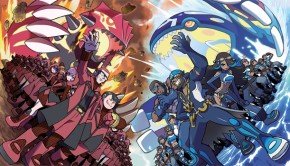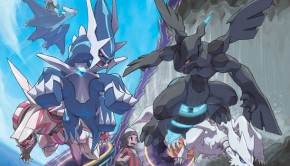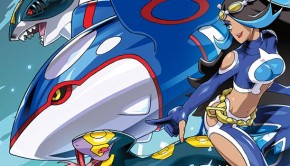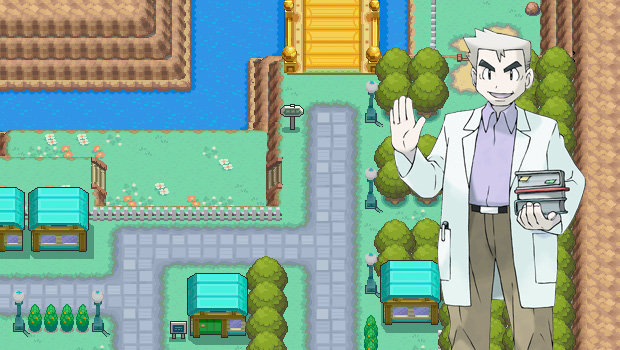A One-Way Ticket to One-Hundred Wins: An Introduction to the Battle Subway
“The foe’s Dewgong used Sheer Cold!
It’s a One-Hit KO!“
A familiar sight. The stars align against you, and you watch as your Pokemon are defeated, one by one, in a perfect storm of hax… Welcome to the Battle Subway! The Battle Subway, or the Battle Tower as it was known in previous generations, is an in-game facility that originated in Pokemon Crystal, where trainers would challenge a set of 7 CPU controlled opponents and win a prize at the end. It has become a hobby for some people to try to see how long of a winning record they can acheive in the Battle Subway, trying to get the best record amongst your friends, and proving those who say that the CPU cheats wrong. This article serves to provide a guideline on some of the basics for getting a long win streak in the Battle Subway, and also some insight at the end on how some of this can be applied to real battles. The goal is that you should be able to reach a 100 win streak after reading this guide.
Table of Contents
- Risk Management
- Predicting the AI
- Knowing the Pokemon
- Knowing the Trainers
- Team Building Tips for Singles and Doubles
- Application to Real Battles
Although a lot of points in this article can be applied to past generations, this article will focus solely on the Battle Subway. Keep in mind that the Battle Subway in both Black/White and Black/White 2 are the SAME.
1. Risk Management
When planning to go for a long winning streak, consistancy is crucial. The number of things that can go wrong in a Pokemon battle are numerous, and by Murphy’s Law, those things that can go wrong will go wrong. There is nothing quite like losing due to missing 4 or 5 consecutive Meteor Mashes. If you feel that you have built a team that can stand up to anything in a clean fight, why give the opponent opportunities to hax you out? You can’t control all the luck in a battle, but that shouldn’t stop you from making the effort to reduce openings.
One of the easiest places to start is by making a shift towards using 100% accurate moves in the Battle Subway. Powerful moves such as Stone Edge, Fire Blast, and Draco Meteor, that one wouldn’t give a second though about using as their primary form of offense, are much less favourable options when you have to bank on them for a good one or two hundred battles, especially when a single loss means that you have to start all over again. After all, where winning 90% of the time in competitive battling would be considered really good, winning 90% of your matches in the Battle Tower would mean that you’d have a hard time even getting past a single set of 7 Trainers. Unfortunately, even when you do use 100% accurate moves, there are still some Pokemon that hold Lax Incense or BrightPowder and some that run Double Team and Minimize that one must watch out for.
The next point of managing risk is to deal with extra effects of opponent attacks. Effects such as burn, confusion, flinches, freeze, paralysis, and critical hits, though low in frequency, are often game turning. There are two major ways of handling these factors. One is used often in Single battles, while the other is easier to perform in Double battles. The one that is used often in Single battles is the usage of Substitute for setup Pokemon. By having a Substitute, you prevent the opponent from hitting your Pokemon with status effects, along with stopping them from bypassing defensive boosts and KOing with critical hits. The other method is simply to defeat the opponent’s Pokemon before they can move. This is easier to perform in Double battles, since you can use both of your active Pokemon to try to handle any one problem Pokemon that may show up, though it is still possible to do this in Single battles with Pokemon such as Shell Smash Cloyster or Choice Scarf Garchomp. If the opponent has fainted, the opponent can’t try to do anything to you. This method is a lot quicker in dealing with opponents, but is more vulnerable to items such as Quick Claw, Lax Incense, and BrightPowder.
Naturally, there are other things that can be done to reduce your risk to yourself, but in many cases they require some more knowledge which we will get to in a bit. Once your team is reasonably consistent, it becomes easier to determine what the real flaws that exist on a team are and what can be done about them.
2. Predicting the AI
The AI for the opponents in the Battle Frontier can be relatively straightforward and predictable in their actions. While I can go into fine detail about many aspects of the CPU AI, it would be best to learn of a few key points.
a. If the opponent has a move that will KO your active Pokemon, the opponent will drop everything and go on the offense
As stated, the opponent will go for the kill at the slightest notice. If they have multiple moves that they can use, they will use Priority moves if applicable, otherwise it is somewhat random what they choose. There are a few exceptions to this rule. The first one is that the CPU cannot calculate the damage properly for the following moves: Gyro Ball, Grass Knot, Low Kick, Return, and Frustration. Another one is that the CPU will sometimes value using Trick Room and Trick over KOing a Pokemon.
If you’re wondering how they “know” when a move is supposed to be a kill or not, the CPU knows the defense and remaining HP of your Pokemon, in order to perform a damage calculation to decide what to do. If they even have a very slight chance and dealing a finishing blow to one of your Pokemon, they will go for it.
b. There are four major scenarios where the opponent will switch out
The CPU, for the most part, does not switch. This factor is one of the biggest things to capitalize on when playing in the Battle Subway. You can switch in a counter to the opponent’s active Pokemon and set up or KO them without worry of the CPU switching out for a counter of their own. Keep an eye out for U-Turn and Volt Switch, however. The four situations that the CPU will switch are:
1. When their Pokemon is Perish Count 1. For obvious reasons, they will always switch out from Perish Song if able, but only when the Count is at 1.
2. When a Pokemon with Natural Cure is afflicted with a status effect. The CPU will switch out the Pokemon in order to heal its status. This doesn’t always happen, and tends to occur more often for curing Sleep or Freeze, as opposed to something like Poison.
3. Switching in a Pokemon that is immune to the previous move used. This one is a bit of a strange one. Although it sounds like it would cause the CPU to switch out quite a lot, they actually rarely do this. Another silly thing about this is that they may switch out even if the Pokemon that had used the attack had already fainted (in double battles at least). For example, I had a Typhlosion hit the opponent with Eruption but was then KO’d. On the next turn, I send out Garchomp and use Earthquake, and the opponent switches out one of their Pokemon for Flareon to brace themselves for another Eruption from my deceased Typhlosion.
4. When the CPU has no damaging moves that can harm your active Pokemon, provided that they have damaging moves in the first place. This is the only case where they can potentially switch out on Turn 1. In addition, as of the Battle Subway, the CPU will also switch if they are locked into a non-damaging move, or an attacking move you are immune to due to holding (or being Trick’d) a Choice item.
c. The CPU does not catch on to patterns
This one is best described using an example. The opponent is running a Starmie with Surf/Psychic/Thunderbolt/Ice Beam. You have a Garchomp and a Suicune. Garchomp is slower and will be OHKO’d by Ice Beam, while Suicune will have troubles setting up Calm Minds while under fire of Thunderbolts. However, if you switch between Garchomp and Suicune repeatedly, you can block Thunderbolts with Garchomp and have Suicune waste away all of Starmie’s Ice Beams while taking minimal damage with the CPU not catching on to your actions. Just be sure to keep track of how many Ice Beams it has left.
d. The CPU will avoid using spread moves that hit all targets if they will damage their ally, and will favor using them if their ally is immune
Naturally, this is something that applies only to Double Battles, and point “a” takes priority over this one. This means that opponent Pokemon that run Earthquake and Surf are often a lot less dangerous than they normally would be, since they won’t use it for fear of damaging their own ally, even if said ally is something like Kingdra, who would take negligable amounts of damage from an ally’s Surf.
3. Knowing the Pokemon
There is a limited number of Pokemon that you can face in the Battle Subway. Some species of Pokemon do not show up at all when you reach past Battle 28 on a Super Subway Line, such as Azelf, Wobbuffet, Shedinja, and Jellicent. For all the Pokemon that do show up, each species only has 4 different sets, each with their own item, nature, EV spread, and moveset.
Totalling it up, there are 780 different Pokemon sets that you can face in the Battle Subway. Knowing the Pokemon that you can face against helps even the odds cosiderably when using a team in the Battle Subway, and determine what an opponent is capable of doing from a limited amount of information. One example would be facing against Ferrothorn. Ferrothorn is normally dangerous to Water-type Pokemon, since it easily shrugs off Water-type moves, and hit back hard with Power Whip. However, none of the Ferrothorn movesets in the Battle Subway run Power Whip, or any Grass-type moves at all, which means that a Water-type Pokemon does not need to worry as much about Ferrothorn’s offensive moves, allowing them to be able to set up or even defeat it if they are packing Fighting-type moves.
There are many resources available that have a list of all the Pokemon you can face in the Battle Subway. You can find one of them here.
4. Knowing the Trainers
Some people may think that the trainer you face in the Battle Frontier is simply just flavor text and has no real relevance to a battle, however this is simply not true. In fact, paying attention to the trainer you are facing against is one of the most important things to do during your Battle Subway battles.
There are 300 different trainers in the Battle Subway, excluding special trainers such as the Subway Boss. Only 100 of those trainers show up beyond a certain point in a winning streak. These 100 trainers can be divided into two categories, tentatively “Themed” and “Non-Themed” teams.
Non-Themed teams are teams that run a wide assortment of Pokemon. They have about 60 or so different Pokemon that they choose from, but each Pokemon will only have one moveset, and all the Pokemon will be from the same set of movesets, which is dependant on the Trainer you face. By knowing the trainer you face, and using a reference list of Battle Subway Pokemon, it is possible to know exactly which moveset the Pokemon you are fighting against has before it makes a single move!
Themed teams are a bit different. They run fewer species of Pokemon, but multiple movesets for each of these Pokemon. The Pokemon they have will have a theme. This can be something simple as a Type-theme, or Legendary Pokemon only, or OHKO theme, or can be a bit more complex, such as a Weather based team, or Intimidate & Wall team. While it isn’t possible to determine the moveset before a move is made against these trainers, the number of Pokemon species that they can use follows a them and are much fewer in number, allowing you to plan ahead and determine which of your Pokemon will be helpful, and which will not, for defeating the opponent.
Further information reference about Trainers can be found here.
5. Team Building Tips, Singles, and Doubles
This section will cover some pointers for bulding and running a team in the Battle Subway. As you may notice, a lot of information here can apply to battles elsewhere.
a. Importance of Leads
Since your lead Pokemon cannot be changed during a set of 7 battles, it will be sent out to face any of 780 potential opponent Pokemon. While there is no way you can have one Pokemon that can deal with all 780 of them (and if you could, you wouldn’t really even need a team!), what you lead with should be effective on a good handful of opponents. If your lead Pokemon is consistantly being forced to retreat at the beginning of the battle, it is simply wasting a turn and causes you to take longer to get yourself into gear in the battle.
For Single battles, a good lead should either be able to handle a large number of Pokemon without much set-up or support, or focuses on debilitating the opponent in order to set-up one of your other Pokemon to sweep. Examples of the former include Cloyster, Garchomp, and Gengar, while the latter includes Pokemon such as Mesprit, Whimsicott, and Shuckle.
For Double battles, things are a bit different. Having a pair of leads will allow you to cover a lot more than a Single battle lead ever could; however, you will also end up in much worse shape during the few times that the opponent catches you with a counterteam matchup. Effective leads in Double Battle Subway follows similar principles to choosing an effective lead to a VGC battle. Fast, hard-hitting Pokemon, auto-weather Pokemon, and supportive Pokemon that have Intimidate, Fake Out, or Follow Me / Rage Powder all make strong lead choices for the Doubles Subway.
b. Defensive synergy, Switching
Due to the AI not switching out from unfavourable match-ups, and the restriction on the number of Pokemon on your team, having some defensive synergy is very important. It’s often not recommended for teams to to run Pokemon with common weaknesses, especially to common offensive types, such as Ground, Rock, Fighting, Ice, Water, and Fire. Taking it a step further, for each weakness that a Pokemon has, you should have another Pokemon that is resistant or immune to the type and can switch in and cover the weakness.
In the Battle Subway, it’s best to be conservative. Things ultimately go back to the idea of risk management. Keeping your entire team alive, and not letting your Pokemon take unnecessary damage from taking risks will allow you to keep switch options open in the battle. Conversely, there are times when it is better to let a Pokemon go, so you can get your counter safely onto the field. For example, having a team with Latios, Garchomp, and Metagross. Metagross is the only Pokemon that can take Ice-type moves, however switching in recklessly can lead to Metagross being taken out by a freeze on the switch in. In this case, it may end up being better to sacrifice Latios or Garchomp to get Metagross in, especially against trainers such as the Ice Workers, who primarily use Ice-type Pokemon.
Defensive battling and switching in the Singles Subway tends to follow what has been mentioned, but once again, the Doubles Subway is slightly different. In addition to aforementioned points, by having Protect on your Pokemon, you can have a Pokemon act as a decoy when at risk of being KO’d as the AI will almost always try to finish off the weakened Pokemon.
c.Sample Strategy, Singles
One of the most successful Single Battle strategies is to run a Pokemon with Trick and a Choice Scarf. The goal is to lock the opponent into a single move, abusing the fact that they do not switch. This is then followed up by further debilitation, in the form of moves such as Thunder Wave, Charm, Flash, and Memento. Afterwards, a set-up sweeper, such as Dragonite, Garchomp or Drapion can power themselves up to the max without fear, and finish off the entire opponent’s team.
Since opponents in the Battle Subway will switch when locked into a non-damaging move, a variation of this is to use an Entrainment Dream World Durant. Durant’s Dream World ability, Truant, will cause the opponent’s Pokemon to act every other turn, so a set-up Pokemon that knows Protect and a powerup move can easily set themselves up for a sweep.
d.Sample Strategy, Doubles
The only automatic weather changers in the Battle Subway are Tyranitar, Abomasnow, and Hippowdon. So naturally, a rain team with a Dream World Politoed is very effective in the Battle Subway. By holding a Choice Scarf and paring Polioed with a Swift Swim Pokemon, such as Ludicolo or Kingdra, the team can easily mow down the opposition by constantly using Surf. Naturally, Grass-type Pokemon and Trick Room users can be a problem, but both can be dealt with by using appropriate Pokemon on the bench; for example, Scizor, Gastrodon, Dragonite, Toxicroak, and Kingdra all make good choices for the back end of a Battle Subway rain team.
6. What you can take from the Subway
While I will go on record saying that playing against CPU opponents in the Battle Frontier isn’t that good of a substitute for battles against human opponents (unless you spend a considerable amount of time playing in the Subway), there are still a good number of things that you can take from your battles here and apply to real competitions.
a. Learning the capabilities of uncommon Pokemon
This one can be pretty useful. Surprise factors can play an important part in a competitive Pokemon battle, either through a Pokemon’s EV spread, its moves, or by simply being a underutilized species that plays a specific role. Regigigas cannot learn Protect, but did you know that it can learn Wide Guard? By seeing the capabilities of many different Pokemon, it teaches you not to underestimate strange Pokemon choices and sometimes allows you to know the opponent’s surprise before they get to show it off.
b. Using information. Planning your moves. Predicting your opponents.
Playing Battle Subway provides the most basic groundwork for learning how to read ahead in a battle and predict your opponent. In the Battle Subway, you essentially play against an opponent who performs obvious and often easily understood actions, while using Pokemon that you can determine the entire moveset, EV spread, nature, and item from little to no information provided in a battle.
c. Hax tolerance
Through the combination of running a team that has a more reliable chance at victory, and the opponent being a lot easier to predict, most of your losses will be due to luck variables, often along the lines of a 1/100 chance or less. Not including the luck factors involved for you to have faced the particular situation in the first place. After a while you stop being bothered so much by things like Quick Claw Fissure Donphan, or missing a few too many times against a Garchomp in a Sandstorm. Nobody likes losing a match due to extreme luck factors, especially in a tournament setting, but having the ability to quickly get over a bad loss can help save you from making mistakes further down the road with the VGC running a Swiss format.
d. Reading HP meters
This one is mostly for the cases where people practice battling other people on a battle simulator. You do not get a battle log that states the % damage your moves deal to your opponents when playing on cartridge, so it becomes up to your own judgment whether an attack did just over or just under half the opponent’s HP and whether you should risk going for a KO or not. Playing Battle Subway provides a place to quickly play a large number of battles in-game, which can allow you to better gauge an opponent’s HP bar to make better estimates for your attacks.
e. Learning rough damage estimates for your attacks
Similar to the previous point, by playing in the Battle Subway for a decent amount of time you will end up getting a feel for how much damage your moves deal to a wide variety of Pokemon, some with varying defensive EV spreads. Of course, this information is only useful for the Pokemon that you actually used in the Battle Subway at the time, and you will have to relearn some damage estimates if you decide to run different Pokemon.
6. Provides a starting point for a team to use in GBU Single and Double battles
Playing Battle Subway leaves you with a team of 3 or 4, which has been tested on a lot of different situations. Why not take it to the next step and convert the team for usage on the GBU? Unless the team’s strategy heavily relies on the shortcomings of the CPU AI, there should be no reason why the team cannot work against human players.
Conclusion
The Battle Subway is a nice diversion from the grind of testing or battling on GBU and practicing for VGC tourneys. For when you want to play a quick handful of battles and wind down a bit, while getting a few BP in the process, the Battle Subway is there for you. With this, you should be have the information needed to reach 100 wins without too much trouble. For more information about the Battle Subway, regarding resources, teams, and records, check out the following off-site topic.
“Bravo!! Your talent has brought you to the destination called Victory! However, your journey has just started. When you choose your next destination, go full speed ahead!”
Article image created by feathers for Nugget Bridge. View more of her artwork on her tumblr or Nugget Bridge forums thread.










